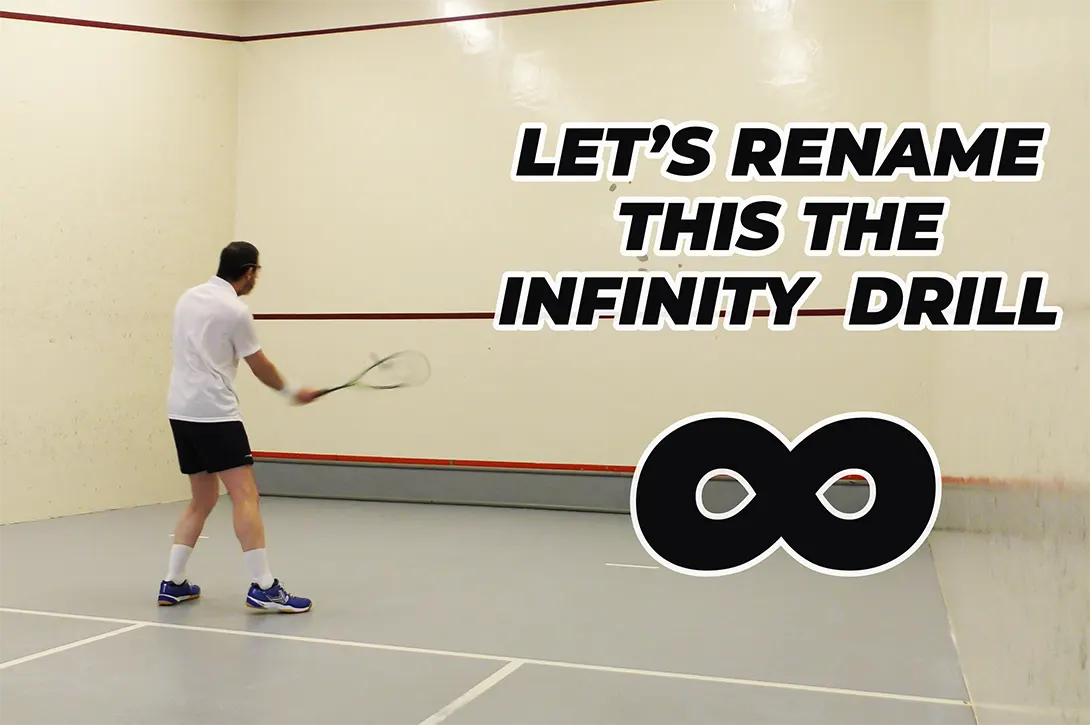Figure Of Eight: Solo Drill
This drill is also called “The Butterfly”, but I prefer the name “infinity” as the shape the ball-path makes is more like the infinity symbol than an eight (∞ vs 8), also the idea that you could do the drill for infinity if you were good enough!
20 June 2022 / 4-Min Read / Translate
This is one of the most common solo drills seen performed by professional squash players. In many ways it’s like the speed ball used by boxers. It doesn’t have any direct relation to what you do in a real match, but it does improve your timing, control, concentration and believe it or not, your core strength.

Can you see what I am doing wrong? That's right, I'm not watching the ball hit my strings.
Start With The Bounce Version
The first version you should try is on the bounce. This allows you more time and space to make adjustments if your shot is not very accurate. Hit a forehand into the left corner (assuming you are right handed), aim the ball to hit the front wall quite close to the side wall, it will then come back towards you on your left side. You then hit a backhand into the right corner, aiming to hit the front wall near the side wall. It will then come back to your forehand side, and so on.
Start with a rd dot or single yellow dot, it’s better to make sure the ball is quite warm before you start, but it’s not necessary. Don’t hit it hard to begin with or too low. Your objective is to build a rhythm that feels comfortable for you. The temptation is to begin to hit harder and lower, try to resist that urge at first. Watch the short video below to see me performing the bounce version.
Move Onto The Volley
Once you feel comfortable with the bounce version you can move onto the volley version, although you don’t have to have mastered it to try. It’s exactly the same, except you volley the ball. Volley means to hit the ball before it bounces (that’s why volleyball is called volleyball!).
Volleys in squash are generally more difficult than shots that bounce because you have less time to prepare to get into the correct position, less time means a shorter swing, which means your technique must be better and your arm stronger, and finally the ball is moving faster, which requires more control. Phew, it’s a big jump and often players find the bounce version of this solo drill a LOT easier than the volley, but with practice (not too much each day though).
Keep your swing quite compact, at least until you can do 20 consecutive shots with no mistakes. When you have mastered this drill, take a step forward towards the front wall. You will need to adjust the angle you hit the ball, but you should be able to keep it going. Play the video below to see me performing the bounce version.
Here is the volley version from another angle.
I got the rhythm just right in this clip.
Better Progression
I do enjoy this drill, but one small change makes it so much better for real-world matches. When the ball comes back to you from a corner, instead of hitting it directly to the other corner, hit a straight shot to yourself and then hit it into the other corner. Five minutes of this specific drill is worth 20 minutes of the basic figure of eight drill! The clip below only shows the volley version, but you can start with the bounce version to get comfortable with it.
It looks easier than it is - so try it before you dismiss it.
Final Thoughts
The Figure of Eight is a great exercise for building strength and control. Perform the drill with the straight shot added to make it even better!